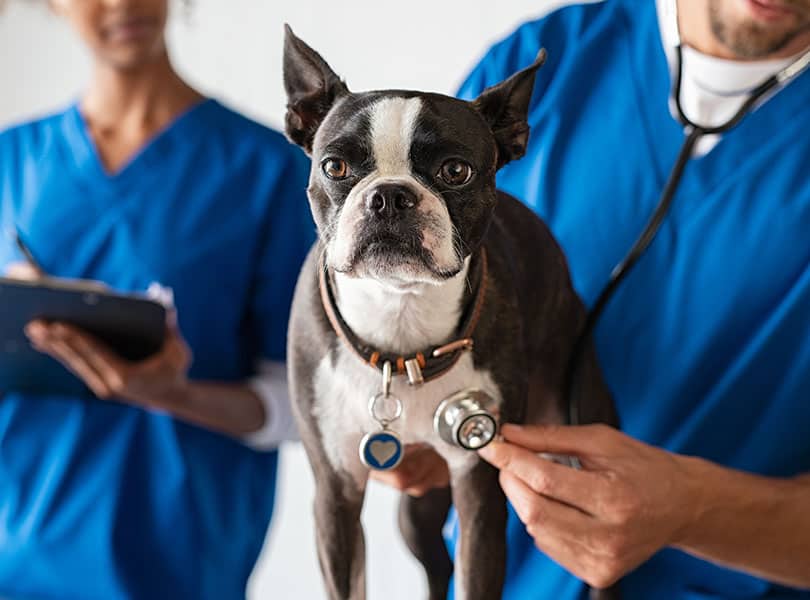How Vets Use CT Scans For Dogs to Monitor Chronic Conditions}
The Role of Ultrasound and CT Check in Modern Vet Practices: Insights From Experienced Professionals
In modern-day vet methods, ultrasound and CT scans greatly enhance analysis capacities. These imaging strategies give critical understandings right into animal health and wellness, assisting treatment decisions. Experienced professionals recognize the one-of-a-kind advantages of each method. Ultrasound uses real-time evaluations, while CT checks provide detailed anatomical information. Recognizing their functions and applications raises essential concerns about their influence on client outcomes and the future of vet diagnostics. What understandings can be acquired from their combined use?
Recognizing Ultrasound in Veterinary Medication
Ultrasound is an important analysis device in vet medicine, offering a non-invasive method to envision interior frameworks. This imaging method uses high-frequency audio waves to create real-time photos of tissues and organs, enabling veterinarians to examine conditions without medical treatment. Typical applications consist of assessing the heart, liver, kidneys, and reproductive organs, as well as keeping an eye on pregnancies.The procedure is fairly quick and can be performed in various settings, making it an available choice for veterinarians. Unlike radiography, ultrasound provides thorough info regarding soft tissues and blood circulation, which is crucial for precise diagnoses.Veterinary professionals rely on ultrasound to identify abnormalities such as tumors, cysts, and liquid build-up. Its capability to guide biopsies and various other treatments further improves its energy in medical technique. By providing a secure and efficient means to analyze inner composition, ultrasound has become a cornerstone of modern-day veterinary diagnostics.
The Advantages of CT Checks for Pet Diagnostics
CT scans deal significant advantages in veterinary diagnostics by offering improved precision in determining inner conditions (Ultrasound For Dogs). As a non-invasive imaging method, they assure the security and comfort of animals throughout evaluations. On top of that, CT scans assist in a comprehensive analysis of internal structures, enabling much more reliable therapy planning
Improved Analysis Accuracy
Developments in imaging modern technology have considerably boosted analysis precision in vet medicine, especially via the use of CT scans. These scans give thorough cross-sectional pictures of a pet's inner frameworks, allowing veterinarians to determine irregularities with accuracy. The high resolution and three-dimensional capacities of CT imaging help with the detection of conditions such as growths, fractures, and interior blood loss that may be missed out on with typical imaging methods. Additionally, CT scans can help in pre-surgical planning by using a thorough view of anatomical relationships. This level of detail not only improves the accuracy of diagnoses but also aids in tailoring efficient treatment plans. The integration of CT technology right into vet methods is changing the landscape of animal healthcare, enhancing end results for clients.
Non-Invasive Imaging Method
The introduction of non-invasive imaging techniques has actually transformed animal diagnostics, with CT checks arising as a prominent device in vet methods. These scans offer high-resolution, cross-sectional pictures of a pet's interior structures, permitting veterinarians to assess intricate problems without the need for intrusive treatments. The benefits of CT scans include their capacity to identify growths, fractures, and internal blood loss with amazing precision. In addition, they help with the assessment of soft tissues and body organs, improving analysis abilities. The rate of CT scanning allows quick decision-making, which is vital in emergency situation circumstances. By minimizing anxiety and discomfort for the pet, CT scans contribute to an extra gentle method to diagnostics, inevitably enhancing therapy outcomes and advancing vet care.
Comprehensive Internal Analysis
A thorough interior assessment is important for precise medical diagnosis and efficient treatment in veterinary medicine. CT checks deal significant benefits hereof, giving thorough cross-sectional photos of an animal's inner structures. This innovative imaging modality enhances visualization of complicated anatomical areas, allowing vets to recognize problems such as lumps, cracks, and interior bleeding with greater precision. On top of that, CT scans promote the assessment of conditions that might be challenging to identify via standard methods. The rate and precision of CT imaging additionally contribute to timely treatments, boosting patient results. As vet techniques progressively include CT innovation, the benefits of comprehensive inner analyses come to be apparent, reinforcing the relevance of this device in contemporary vet diagnostics.
Contrasting Ultrasound and CT Imaging Techniques
While both ultrasound and CT imaging offer important functions in vet diagnostics, each technique offers distinct advantages and restrictions that can influence medical decision-making. Ultrasound is especially valued for its real-time imaging capabilities, enabling vets to observe dynamic physical procedures. This technique is non-invasive, mobile, and does not entail ionizing radiation, making it a more secure option for both pets and medical professionals. However, ultrasound may have constraints in imagining particular physiological structures or deep tissues.Conversely, CT imaging offers comprehensive cross-sectional sights of the body, enabling precise localization of problems. It masters reviewing complex body organs and frameworks, specifically in the thorax and abdomen. Nevertheless, CT scans require sedation or anesthetic in most cases and entail direct exposure to ionizing radiation. Ultimately, the option in between ultrasound and CT depends on the particular professional situation, the location of interest, and the necessity of the diagnostic demands.
Case Studies: Effective Diagnoses With Imaging
Study highlight the significant improvements in diagnostic precision achieved with innovative imaging technologies like ultrasound and CT scans in vet methods. These developments not just enhance the discovery of different problems but likewise promote reliable and prompt treatment plans. Assessing specific situations can highlight the transformative effect of these imaging methods on vet medication.
Diagnostic Accuracy Improvements

Imaging Innovation Advancements
As vet imaging modern technology proceeds to evolve, its impact on diagnostic abilities comes to be increasingly evident. Recent study highlight the successful application of advanced ultrasound and CT scan techniques in identifying complex conditions. For example, a vet clinic made use of high-resolution CT scans to detect an unusual form of lung cancer cells in a pet, which standard imaging had missed out on. In a similar way, an ultrasound assessment exposed an abdominal mass in a cat, triggering timely medical intervention and a favorable result. These advancements not just enhance diagnostic precision however also make it possible for veterinarians to devise targeted therapy plans. By leveraging cutting-edge imaging modern technologies, vet professionals are markedly boosting patient treatment, bring about a lot more efficient administration of numerous health and wellness conditions in animals.
The Role of Imaging in Emergency Vet Treatment
Imaging plays an important function in emergency vet care, giving veterinarians with vital info required to make rapid, enlightened choices. In urgent situations, techniques like ultrasound and CT scans allow specialists to promptly assess a family pet's internal structures, recognizing essential conditions such as interior bleeding, fractures, or organ irregularities. These imaging modalities enable real-time examinations, facilitating timely interventions that can be life-saving. Ultrasound is invaluable for assessing soft cells injuries and problems like liquid buildup, while CT checks deal detailed images of intricate physiological frameworks, necessary for detecting trauma cases. The rate and accuracy of these imaging methods enhance the vet's capacity to devise reliable therapy plans, guaranteeing the ideal possible outcomes for their clients. As a result, the assimilation of sophisticated imaging innovations into emergency veterinary practices is not just beneficial yet progressively needed, as it improves diagnostic capacities and improves overall pet treatment during crucial moments.
Training and Competence in Veterinary Imaging
Advanced imaging strategies such as ultrasound and CT scans are necessary for efficient vet treatment, the successful implementation of these modern technologies heavily depends on the training and proficiency of veterinary experts. Skillful use imaging tools needs detailed knowledge of composition, pathology, and the concepts underlying each method. Veterinary experts have to undergo specific training to precisely analyze imaging outcomes, which is try this site essential for diagnosing conditions and planning treatment.Certifications and proceeding education and learning in veterinary imaging enhance the skills of professionals, allowing them to stay upgraded with technological developments. Cooperation in between radiologists and vets often results in improved diagnostic accuracy, as specialists can supply insights into complicated situations. On top of that, sensible experience in handling imaging equipment fosters self-confidence in its application. Eventually, the high quality of veterinary imaging solutions is straight associated to the degree of training and knowledge possessed by the experts using these vital diagnostic tools.
Future Trends in Diagnostic Imaging for Animals
With the rapid advancements in technology, vet analysis imaging is poised for substantial evolution in the coming years. Arising patterns suggest a change in the direction of more available and portable imaging methods, such as handheld ultrasound devices, which can improve field diagnostics. Additionally, the assimilation of expert system is expected to change picture analysis, enabling quicker and a lot more accurate analyses of results.Moreover, developments in 3D imaging techniques and computed tomography will certainly offer vets with more thorough sights of animal anatomy, bring about enhanced treatment strategies. Online reality innovation might likewise play a duty in medical planning and education, giving vets an unique point of view on complicated cases.As telemedicine remains to expand, remote appointments promoted by diagnostic imaging will certainly become a lot more common, enabling professionals to assist basic practitioners in real-time. On the whole, these trends are readied to enhance the performance and effectiveness of veterinary treatment, ultimately boosting animal outcomes.
Often Asked Inquiries
Just How Much Do Ultrasound and CT Scans Expense in Vet Facilities?
The prices of ultrasound and CT scans in veterinary centers generally vary from $300 to $1,500, depending upon aspects such as area, clinic type, and particular treatments required for the pet's medical diagnosis and therapy.

Are There Any Threats Connected With Ultrasound and CT Checks for Animals?
Ultrasound and CT scans generally posture very little threats to family pets. Potential worries include sedation responses and exposure to anesthetics. Vets carefully analyze each situation to minimize any kind of dangers connected with these analysis treatments
Exactly How Lengthy Do Ultrasound and CT Procedures Typically Take?
Ultrasound treatments normally take around half an hour to an hour, depending on the intricacy. CT scans, being more detailed, typically call for thirty minutes to 90 minutes, consisting of preparation and recuperation time for the pet.
Can All Veterinarians Perform Ultrasounds and CT Scans?
Not all veterinarians can execute ultrasounds and CT scans. Specialized training and accreditation are typically needed to guarantee expertise in these advanced imaging strategies, which may limit their availability to vets with extra certifications and resources.
What Sorts Of Animals Profit A Lot Of From These Imaging Techniques?
Certain pet types, especially cats and pet dogs, benefit greatly from ultrasound and CT scans. These imaging methods improve diagnostic precision for conditions like tumors, internal injuries, and organ irregularities, bring about improved treatment outcomes and patient care. The high resolution and three-dimensional abilities of CT imaging assist in the discovery of conditions such as growths, fractures, and internal bleeding that may be missed with standard imaging approaches. Instance research studies highlight the considerable improvements in diagnostic accuracy accomplished with innovative imaging modern technologies like ultrasound and CT scans in veterinary practices. Improving analysis accuracy in veterinary methods has been considerably aided by developments in imaging technologies such as ultrasound and CT scans. Innovative imaging techniques such as ultrasound and CT scans are essential for effective veterinary treatment, the effective execution of these technologies heavily depends on the training and proficiency of veterinary professionals. Vet specialists have to undertake specific training to properly analyze imaging results, which is crucial for detecting conditions and intending treatment.Certifications and proceeding education in veterinary imaging improve the abilities of specialists, enabling them to remain updated with technical advancements.